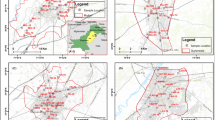Abstract
This study was carried out to assess the fluoride levels of groundwater from open wells, consumed by the residents of three communities located in two distinct geological terrains of southwestern Nigeria. Fluoride concentration was determined using spectrophotometric technique, while analysis of other parameters like temperature, pH and total dissolve solids followed standard methods. Results of the analysis indicated that groundwater samples from Abeokuta Metropolis (i.e., basement complex terrain) had fluoride content in the range of 0.65 ± 0.21 and 1.20 ± 0.14. These values were found to be lower than the fluoride contents in the groundwater samples from Ewekoro peri-urban and Lagos metropolis where the values ranged between 1.10 ± 0.14–1.45 ± 0.07 and 0.15 ± 0.07–2.20 ± 1.41 mg/l, respectively. The fluoride contents in almost all locations were generally higher than the WHO recommended 0.6 mg/l. Analysis of Duncan multiple range test indicated that there is similarity in the level of significance of fluoride contents between different locations of same geological terrain at p ≤ 0.05. It was also observed that fluoride distribution of groundwater samples from the different geological terrain was more dependent on factors like pH and TDS than on temperature. The result of the analyzed social demographic characteristics of the residents indicated that the adults (between the age of 20 and >40 years) showed dental decay than the adolescent (<20 years). This signifies incidence of dental fluorosis by the high fluoride content in the drinking water of the populace. Further investigation on all sources of drinking water and other causes of tooth decay in the area is suggested.
Similar content being viewed by others
References
Agagu, K. O. (1985). A geological guide to bituminous dements in southwestern Nigeria. Journal of Petroleum Geology, 5, 91–102.
Egboka, B. C. E. (1987). Water resources problem of Enugu area of Anambra State, Nigeria (pp. 119–125). I.A.H.S. publ. no. 153.
Fayose, E. A. (1970). Stratigraphy and paleontology of the afowo well. Journal of Mining and Geology, 5, 1–99.
Gikinju, J. K., Simiyu, K. W., Gathura, P. B., Kyule, M., & Kanja, L. W. (2002). River water fluoride in Kenya. Research Report, 35(3), 193–196.
Iloeje, N. P. (1981). A new geography of Nigeria (p. 201). Nigeria: Longman.
Jones, C. A., & Hockey, H. A. (1964). Geology of parts of Southwestern Nigeria. GSN Bulletin, 31, 63–72.
Karunakaran, J. M. (1974). Analytical information on percentage fluorine content. Geological Society of India, 15, 115–122.
Knutsson, G., & Olofsson, B. (2002). Fluoride content in groundwater from drilled wells in the Stockholm region of Sweden. NGU-BULL, 439, 79–85.
Krenkel, P. A. (1974). Sources and classification of water pollutants. In N. I. Sax (Ed.), Industrial pollution (pp. 197–219). NY: Von Nostrand Reinhold.
Krrishnamohan, K., & Muthukrishnan, N. (1996). Fluoride pollution of groundwater, reaching the unreached: Challenges for twenty-first century. In 22nd WEDC conference, discussion paper, pp. 273–274.
Latha, S. S., Ambika, S. R., & Prasad, S. J. (1999). Fluoride contamination status of groundwater in Karnataka, India. Current Science, 76(6), 730–734.
Miller, G. W. (1993). The effect of fluoride on higher plants with special emphasis on early physiological and biochemical disorders. Fluoride, 26, 3–22.
Moturi, W. K., Tole, M. P., & Davies, T. C. (2002). The contribution of drinking water towards dental fluorosis: A case study of Njomo Division, Nakuru District, Kenya. Environmental Geochemistry and Health, 24, 123–130.
Naegele, J. A. (1974). Effects of pollution on plants. In N. I. Sax (Ed.), Industrial pollution (pp. 82–100). NY: Von Nostrand Reinhold.
NEST. (1991). Nigeria’s threatened environment (p. 288). Nigeria: A Nigerian Environment Study/Action Team (NEST).
Ogbe, F. G. A. (1972). Stratigraphy of strata exposed in the Ewekoro quarry, Western Nigeria. In A. J. Whitman & T. F. J. Dessauvagie (Eds.), African geology (pp. 305–322). Ibadan: University of Ibadan, Ibadan Press.
Oguntoyinbo, J. S., Areole, G. O., & Filani, M. (1983). A geography of Nigeria development (2nd ed., p. 456). Nigeria: Heinemann Education Books.
Olanrewaju, V. O., Olorunfemi, M. O., & Alade, O. (1997). Chemical characterization of groundwater from some parts of the basement complex of Central Nigeria. Journal of Mining and Geology, 33(2), 135–139.
Omatsola, M. E., & Adegoke, O. S. (1981). Tectonic evolution and cretaceous stratigraphy of the Dahomey Basin. Journal of Mining and Geology, 18, 130–137.
Onakomaya, S. O., Oyesiku, K., & Jegede, J. (1992). Ogun state in map (p. 187). Ibadan: Rex Charles.
Rameshan, V., & Rajapopalan, K. J. (1985). Fluoride ingestion into the natural waters of hard-rock areas, Peninsular India. Journal of Geological Society of India, 26, 125–132.
Sax, N. I. (1974). Industrial pollution (p. 702). NY: Von Nostrand Reinhold.
Sharma, S. K. (2003). High fluoride in ground water cripples life in parts of India (pp. 15–16). Medical geology newsletter. IUGS special initiative on medical geology. Newsletter no. 7.
Strahler, A. N., & Strahler, A. H. (1973). Environmental geosciences: Interaction between natural system and man (p. 511). NY: Wiley.
Tijani, M. N. (1994). Hydrogeochemical assessment of groundwater in Moro area, Kwara State, Nigeria. Journal of Environmental Geology, 24, 194–202.
Tijani, M. N., & Ayodeji, O. A. (2001). Hydrogeochemical assessment of surface and groundwater resources in part of Dahomey Basin, South Western Nigeria. Water Resources Journal of the Nigerian Association of Hydrogeologists, 12, 88–93.
World Health Organization. (1994). International standards for drinking water from water quality criteria and standards for industrial effluents (pp. 23–39). New York: McGraw Hill Book Co.
World Health Organization. (2006). Fluorides in drinking water. In K. Bailey, J. Chilton, F. Dahi, M. Lennon, P. Jackson, & J. Fawell (Eds.), WHO drinking water series. London: IWA.
World Health Organization (WHO). (1971). International drinking water standards (3rd ed.). Geneva.
World Health Organization (WHO). (1977). International drinking water standards. Geneva.
World Health Organization (WHO). (2008). Guidelines for drinking water quality. Incorporating the first and second addenda (3rd ed., Vol. 1). Recommendation, Geneva. http://www.enviroequip.com/quipnotes/ORP.htm.
Author information
Authors and Affiliations
Corresponding author
Rights and permissions
About this article
Cite this article
Gbadebo, A.M. Groundwater fluoride and dental fluorosis in southwestern Nigeria. Environ Geochem Health 34, 597–604 (2012). https://doi.org/10.1007/s10653-012-9455-1
Received:
Accepted:
Published:
Issue Date:
DOI: https://doi.org/10.1007/s10653-012-9455-1




